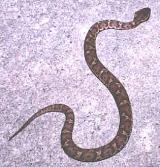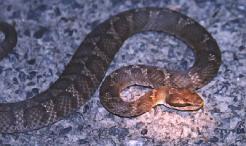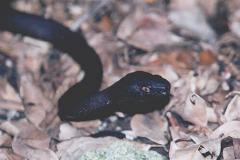Poisonous snakes of Okinawa
Some of the poisonous snakes that can be found on and around Okinawa.
VIPERIDAE(Kusari-Hebi) The family of poisonous snakes.
JAPANESE NAME: Nihon-Mamushi
COMMON NAME: Japanese mamushi
SCIENTIFIC NAME: Agkistrodon blomhoffi or Gloydius blomhoffii
Generally located: Hokkaido, Honsyu, Shikoku, Kyusyu, Kunashirijima Is., Yakishirijima Is., Teurijima Is., Sadogashima Is., Oki Islands, Iki Islands, Gotorettou Islands, Kshikijima Islands, Yakushima Is., Tanegashima Is. and Izuoshima Is.
Approx. total length: 40-65cm
JAPANESE NAME: Tsushima-Mamushi
COMMON NAME: Tsushima mamushi
SCIENTIFIC NAME: Agkistrodon tsushimaensis or Gloydius tsushimaensis
Generally located: Tsushima Islands
Approx. total length: 40-60cm
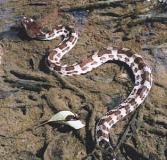
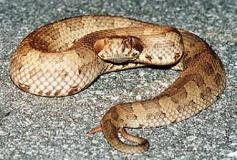 JAPANESE NAME: Hime-Habu
JAPANESE NAME: Hime-Habu
COMMON NAME: Himehabu
SCIENTIFIC NAME: Ovophis okinavensis
Generally located: Amamisyotou Islands and Okinawasyotou Islands except Kikaijima Is., Okinoerabujima Is., Yorontou Is., Ikonajima Is. and Agunijima Is.
Approx. total length: 30-80cm
Quick tip: Himehabu

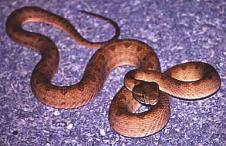 JAPANESE NAME: Sakishima-Habu
JAPANESE NAME: Sakishima-Habu
COMMON NAME: Sakishima habu
SCIENTIFIC NAME: Trimeresurus elegans
Generally located: Yaeyamasyotou Islands except Yonagunijima Is. and Haterumajima Is.
Approx. total length: 50-100cm
Distinctive characteristics of Sakishimahabu
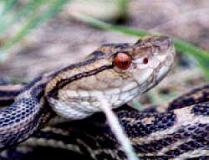
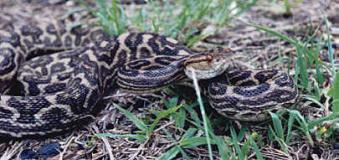 JAPANESE NAME: Habu
JAPANESE NAME: Habu
COMMON NAME: Habu
SCIENTIFIC NAME: Trimeresurus flavoviridis
Generally located: Amamisyotou Islands and Okinawasyotou Islands
Approx. total length: 100-220cm
Beware Habu Snakes, Aggressive Until atleast the month of June.
Quick tip: Habu snake
JAPANESE NAME: Tokara-Habu
COMMON NAME: Tokarahabu
SCIENTIFIC NAME: Trimeresurus tokarensis
Generally located: Takarajima Is. and Kodakarajima Is. of Tokararettou Islands
Approx. total length: 60-100cm
Okinawa Prefecture Health and Environment officials remind residents that the coming rainy season is the time when habu snakes are most aggressive. They warn that for about two months, until the end of June, the snakes are prone to attack if disturbed. The venomous kinds of snakes present on Okinawa that we should be concerned with include the Okinawan habu, the Hime habu, and the Sakishima habu. A fourth snake, the Akamata, is not venomous, but it is very aggressive and bites readily when disturbed.
One hundred and sixteen people in Okinawa Prefecture were bitten by poisonous snakes last year. One died.
The most likely places to encounter a snakes are places infested with rats and mice, as they are the habu’s staple diet. Those who go hiking and camping should use lights during the night as the snakes avoid bright lights. Also a good chance a snakes house is nearby if you find a sheded skin.
Habu are some of the world's deadliest snakes and are quite common on Okinawa.
Habu snakes on Okinawa can be distinguished by the following characteristics:
Habu are usually encountered in dense vegetation or on the roadside. These snakes are periodically sighted in urban areas, however the habu population in isolated areas is much greater.
They are often found in and around tombs, in sugar cane fields, in caves, and in stone walls.
Their color is either yellow-green with dark blotches that alternate on the back (Okinawa Habu), dark brown or gray with more dark blotches along the back (Hime Habu), or with yellow-orange marks that alternate on a dark-gray back (Sakishima Habu).
Heads are triangularly shaped.
Eyes have elliptical (vertical) pupils.
Their faces possess a pit organ that looks like a large nostril between the eye and the true nostril. They use these pits to detect heat that is generated by warm-blooded animals, allowing the snake to "home-in" on its prey.
They have long, needle-like fangs that can inject a hemotoxic venom which increases bleeding and can cause tissue damage.
The Akamata has yellow/orange/reddish bands that alternate with dark patches. Akamatas do not have fangs, venom, pits, or triangular heads, and the pupils of their eyes are round instead of elliptical.
Habu snakes are active at night. During the day they hide in heavily vegetated areas, in caves, tombs, rock piles, among tree roots, etc. All of these snakes will bite at any time of day or season if disturbed. If one were bitten by one of the poisonous snakes and venom was injected, the symptoms would include the following:
Strong, throbbing pain.
Marks of the fangs with blood oozing from site.
Marked swelling. If no swelling is present within 10 minutes after the bite, either no venom was injected or the snake was not venomous.
Bruising of the skin around the bite.
For large amounts of injected venom the victim may have:
Nausea and vomiting.
Disorientation.
Low blood pressure.
Irregular breathing.
If bitten, the following emergency first-aid measures should be taken:
1. Remain calm, or calm the victim. Many snake bites do not involve the injection of venom. However, if venom was injected, then it is important to reduce movement of the bitten limb as much as possible. Excitation increases the heart rate, causing venom to move through the body quicker than normal.
2. Apply a towel or cloth firmly around the bite site. This will slow the bleeding and also slow the spread of venom throughout the bitten area. Do not apply a tourniquet! A tourniquet can pool the venom in one area causing increased damage to surrounding tissues.
3. Immobilize the bitten limb, if possible. Keep the bitten area below heart level and immobilized using a splint or a sling. This will also slow the bleeding and the spread of venom.
4. Seek medical attention immediately. Due to the destructive nature of the venom, disfigured limbs or muscle damage may occur if medical treatment is not received quickly (within 2-3 hours). DO NOT attempt to make an incision or "suck out" the venom!
Many hospitals on the island keep anti-venom on hand in case of emergency. Phone 119 off-base or 911 on base.
Use Caution Outside:
To reduce risks of snake bite, be careful when engaging in outdoor activities and in areas where snakes are likely to hide. Do not explore caves or tombs, especially during this time of year. Use a flashlight at night, and be very careful when stepping or reaching into areas where vision is limited. Remove piles of debris that rodents and snakes like to hide within, like rock or wood piles. Keep grass neatly cut and shrubs trimmed off the ground. Keep lights lit at night outside the home to help repel snakes.
It is time to pay strict attention to our surroundings and be aware that poisonous snakes are out there…be aware, prepared, and safe. If snakes are seen or if action is needed in your area, call your local Provost Marshal’s Office (PMO) for assistance. For more information on snakes or other wildlife on Okinawa, contact the Preventive Medicine Department, Consolidated Preventive Medicine Unit, USNH at 643-7808. Also For more information, please contact the Okinawa Prefectural Government Habu Laboratory (Okinawa-ken Habu Kenkyuu-sho) at (098) 946-6710.
The Habu is an indigenous, venomous snake on Okinawa. Every year approximately 250 people are bitten by habus, usually agricultural workers, but no serious problems resulting from visitors bitten by snakes have been reported to the American Consulate in recent memory. Call 119 (off base) or 911 (on base) immediately if you or anyone else is bitten.
Emergency operators in Okinawa speak no English.
Telephone for OPG (Okinawa Prefectural Government) ambulance/rescue service is 119.
Civilian telephone numbers on Okinawa dialed from outside Japan are 81-98-xxx-xxxx.
Calls to military telephones on Okinawa from outside Japan can be made by:
By autovan
By international direct dial: 81-6117-xx-xxxx (military # minus the initial "6") or through the following base operators: (81-98) 938-1111 for 623/633/643-xxxx
(81-98) 892-5111 for 636/637/641/642/643/644/645-xxxx
(81-98) 972-6700 for 622/623/625/628-xxxx
Regional Medical Officer American Embassy Manila, 632-831-0633
Regional Psychiatrist American Embassy Hong Kong, 662-254-1164
DOD evacuation point for East Asia is USN Hospital, Camp Lester, Okinawa, located about 10 miles north of the Consulate General, telephone 81-98-893-7911. The message address is: NAVHOSP OKINAWA JAPAN
English speaking physicians are available at:
- Adventist Medical Center
- 868 Aza Kochi
- Nishihara-cho, Okinawa, Japan 903-01
- Tel: (098) 946-2833
- Fax: (098)946-7137
- Okinawa Prefectural Chubu Hospital
- 192 Aza Miyazato
- Gushikawa City, Okinawa, Japan 904-22
- Tel: (098) 973-4111
- Fax: (098) 973-2703
The University of Hawaii Post Graduate Medical Education Program is located at Chubu Hospital. The University of Hawaii Program brings U.S. physicians to Chubu Hospital as visiting professors. The specialties of these visiting professors vary.
In addition to the above, the U.S. Naval Hospital (USNH) on Okinawa (PSC 482, FPO AP 96362-1600, Tel: 098-938-1111, ext. 643-7555/7509, Fax: 643-7591) provides a broad range of medical services to the resident American official community as well as emergency services not available at other local facilities, including an emergency medical evacuation capability.
Gyokusendo Kingdom Village also hosts a Habu pit, where visitors can view many different kinds of snakes. There are 7 different kinds of Habu snakes on Okinawa, the Habu snake has a very fast acting venom killing its victim within minutes. Also native to Okinawa waters are the local sea snakes. Usually very placid, most sea snakes carry enough venom to kill several human adults
Habu Research Section
2003 Ozato, Ozato-son, Okinawa, 901-1202 JAPAN FAX (81)098-946-6711
In 1966 The Habu Branch Laboratory was established in the new building constructed at Kyozuka, Urasoe-Village (presently Urasoe City).
In 1974 The installation for ecological study of Habu was constructed.
In 1980 The Institute was moved into the newly-built building at Ozato, Ozato-Village.
In 1983 The Institute was reorganized to comprise two departments, seven sections and a Habu Branch Laboratory.
Habu Research Section is tasked with:
Study of snake venom and antivenom.
Improvement of clinical treatment for Habu-bites.
Epidemiological study of Habu-bites.
Habu control study.
Rearing and handling of snakes.
Ecological study of snakes.

